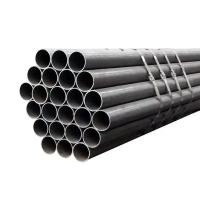Cylinder tube generally refers to honed tube, is a high-precision
steel pipe material that is processed by cold drawing or hot
rolling. Due to the lack of oxidation layer on the inner and outer
walls of precision steel pipes, high pressure resistance without
leakage, high precision, high smoothness, cold bending without
deformation, flaring, flattening without cracks, etc., they are
mainly used to produce products of pneumatic or hydraulic
components, such as cylinders or oil cylinders, which can be
seamless pipes. The chemical components of the grinding tube
include carbon C, silicon Si, manganese Mn, sulfur S, phosphorus P,
and chromium Cr.
We have 4 advanced hot-rolled seamless steel pipe production lines
and 4 cold-drawn seamless steel pipe production lines, which can
produce steel pipes of various specifications and materials. We can
meet your various needs, and provide high-quality products and the
most competitive prices. Our products sell well in hundreds of
large and medium-sized cities in China, and are exported to India,
Thailand, Vietnam, Iran, Turkey, Brazil, Egypt and other countries.
Common Material
- 10#Steel 0.07~0.13 0.17~0.37 0.35~0.65 ≤0.035 ≤0.035
- 20#Steel 0.17~0.23 0.17~0.37 0.35~0.65 ≤0.035 ≤0.035
- 35#Steel 0.32~0.39 0.17~0.37 0.35~0.65 ≤0.035 ≤0.035
- 45# Steel 0.42~0.50 0.17~0.37 0.50~0.80 ≤0.035 ≤0.035
- 40cr Steel 0.37~0.44 0.17~0.37 0.50~0.80 ≤0.035 ≤0.035 0.08~1.10
- 25Mn Steel 0.22~0.2 0.17~0.37 0.70~1.00 ≤0.035 ≤0.035 ≤0.25
- 37Mn5 Steel 0.30~0.39 0.15~0.30 1.20~1.50 ≤0.015 ≤0.020
Major Advantages
- Improve the surface roughness, and the roughness can basically
reach around Ra ≤ 0.08 µ m.
- Correct roundness and ovality can be ≤ 0.01mm.
- Improve surface hardness to eliminate stress deformation, and
increase hardness by HV ≥ 4 °.
- After processing, there is a residual stress layer, which increases
the fatigue strength by 30%.
- Improve the quality of the fit, reduce wear, and extend the service
life of the parts, but the processing cost of the parts is actually
reduced.
Processing Technology
The cylinder tube is processed by rolling. Because the surface
layer has residual pressure stress, it helps to close the surface
micro cracks and blocks the expansion of erosion. This improves
surface corrosion resistance and can delay the generation or
expansion of fatigue cracks, thereby improving the fatigue strength
of the quilted tube.
By rolling forming, a cold work hardening layer is formed on the
rolling surface, reducing the elastic and plastic deformation of
the contact surface of the grinding pair, thereby improving the
wear resistance of the inner wall of the grinding tube and avoiding
burns caused by grinding. After rolling, the reduction of surface
roughness value can improve the fitting properties.

Rolling Processing Principle
Rolling machining is a pressure finishing process that utilizes the
cold plastic characteristics of metals at room temperature to apply
a certain amount of pressure to the surface of the workpiece using
rolling tools, causing plastic flow of the surface metal of the
workpiece and filling it into the original residual low concave
valleys, thereby reducing the surface roughness of the workpiece.
Due to the plastic deformation of the surface metal being rolled,
the surface structure is cold hardened and the grains become finer,
forming a dense fibrous structure and a residual stress layer. The
hardness and strength are improved, thereby improving the workpiece
surface's wear resistance, corrosion resistance, and compatibility.
Rolling is a non-cutting plastic processing method.
Therefore, this method can achieve both finishing and strengthening
purposes simultaneously, which cannot be achieved by grinding. No
matter what processing method is used, refined and uneven tool
marks will always be left on the parts' surface, resulting in
staggered peaks and valleys.

















